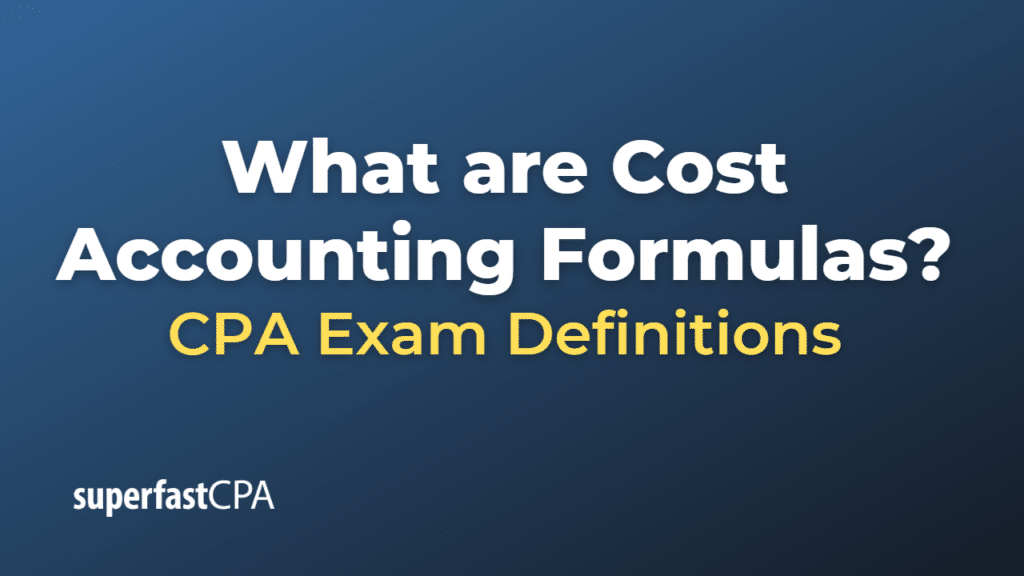Cost Accounting Formulas
Cost accounting formulas are mathematical expressions used to calculate and analyze various cost components associated with an organization’s production, operations, or projects. These formulas help organizations manage costs effectively, make informed financial decisions, and improve profitability and efficiency. Here are some common cost accounting formulas:
- Total cost: The sum of all costs incurred in producing a product or delivering a service.
\(\text{Total Cost} = \text{Direct Costs} + \text{Indirect Costs} \) - Unit cost: The cost per unit of a product or service, calculated by dividing the total cost by the number of units produced or delivered.
\(\text{Unit Cost} = \frac{\text{Total Cost}}{\text{Number of Units}} \) - Direct materials cost: The cost of raw materials used in the production of a product or delivery of a service.
\(\text{Direct Materials Cost} = \text{Quantity of Materials Used} \times \text{Cost per Unit of Material} \) - Direct labor cost: The cost of labor directly involved in the production of a product or delivery of a service.
\(\text{Direct Labor Cost} = \text{Number of Labor Hours} \times \text{Hourly Labor Rate} \) - Overhead costs: The indirect costs associated with the production of a product or delivery of a service, such as rent, utilities, and administrative expenses.
\(\text{Overhead Costs} = \text{Total Costs – Direct Costs} \) - Contribution margin: The amount by which revenue from a product or service exceeds its variable costs.
\(\text{Contribution Margin} = \text{Revenue – Variable Costs} \) - Contribution margin ratio: The ratio of contribution margin to revenue, expressed as a percentage.
\(\text{Contribution Margin Ratio} = \frac{\text{Contribution Margin}}{\text{Revenue}} \times 100 \) - Break-even point (units): The number of units that must be sold for total revenue to equal total costs, resulting in neither profit nor loss.
\(\text{Break-even Point (units)} = \frac{\text{Fixed Costs}}{\text{Selling Price per Unit – Variable Cost per Unit}} \) - Break-even point (sales dollars): The sales revenue that must be generated for total revenue to equal total costs, resulting in neither profit nor loss.
\(\text{Break-even Point (sales dollars)} = \frac{\text{Fixed Costs}}{\text{Contribution Margin Ratio}} \) - Gross profit: The difference between revenue and the cost of goods sold (COGS).
\(\text{Gross Profit} = \text{Revenue – Cost of Goods Sold} \) - Gross profit margin: The ratio of gross profit to revenue, expressed as a percentage.
\(\text{Gross Profit Margin} = \frac{\text{Gross Profit}}{\text{Revenue}} \times 100 \)
These cost accounting formulas play a crucial role in helping organizations manage their costs, support decision-making, and improve profitability. Cost accountants use these formulas to calculate various cost components, analyze cost trends, and provide insights for management to make informed decisions about resource allocation, pricing, and cost control.
Example of Cost Accounting Formulas
Let’s consider an example of a company called “FreshBakery Inc.” that produces and sells a variety of bread loaves. To calculate and analyze the costs associated with producing and selling its bread, FreshBakery Inc. uses various cost accounting formulas:
- Direct materials cost: FreshBakery Inc. uses flour, yeast, and other ingredients to produce its bread loaves. Suppose the company uses 2 pounds of flour per loaf, costing $1.50 per pound. The direct materials cost per loaf is:
\(\text{Direct Materials Cost} = \text{Quantity of Materials Used} \times \text{Cost per Unit of Material} \)
\(\text{Direct Materials Cost} = \text{2 pound} \times \text{\$1.50 per pound} = \$3.00 \) - Direct labor cost: Suppose the company employs bakers who work 500 labor hours per month and are paid $20 per hour. If they produce 2,500 loaves of bread per month, the direct labor cost per loaf is:
\(\text{Direct Labor Cost per Loaf} = \frac{\text{Total Labor Hours} \times \text{Hourly Labor Rate}}{\text{Number of Loaves}} \)
\(\text{Direct Labor Cost per Loaf} = \frac{\text{500 hours} \times \text{\$20 per hour}}{\text{2,500 loaves}} = \$4.00 \) - Overhead costs: FreshBakery Inc. incurs $5,000 in monthly overhead costs, such as rent, utilities, and administrative expenses. The overhead cost per loaf is:
\(\text{Overhead Cost per Loaf} = \frac{\text{Total Overhead Cost}}{\text{Number of Loaves}} \)
\(\text{Overhead Cost per Loaf} = \frac{\text{\$5,000}}{\text{2,500 loaves}} = \$2.00 \) - Unit cost: The unit cost of producing a bread loaf is calculated by adding the direct materials cost, direct labor cost, and overhead cost per loaf:
\(\text{Unit Cost} = \text{Direct Materials Cost + Direct Labor Cost + Overhead Cost} \)
\(\text{Unit Cost} = \$3.00 + \$4.00 + \$2.00 = \$9.00 \) - Contribution margin: Suppose FreshBakery Inc. sells each bread loaf for $12. The contribution margin per loaf, which represents the amount by which the revenue exceeds the variable costs, is:
\(\text{Contribution Margin} = \text{Revenue – Variable Costs} \)
\(\text{Contribution Margin} = \$12 – (\$3.00 + \$4.00) = \$5.00 \) - Break-even point (units): To calculate the number of bread loaves FreshBakery Inc. must sell to cover all its costs and achieve neither profit nor loss, we use the break-even point formula:
\(\text{Break-even Point (units)} = \frac{\text{Fixed Costs}}{\text{Selling Price per Unit – Variable Cost per Unit}} \)
\(\text{Break-even Point (units)} = \frac{\$5,000}{\$12 – \$9} = \text{1,667 loaves} \)
In this example, FreshBakery Inc. uses cost accounting formulas to calculate various cost components and analyze the costs associated with producing and selling its bread loaves. This analysis helps the company make informed decisions about resource allocation, pricing, and cost control to maintain its competitiveness in the market and achieve profitability.













